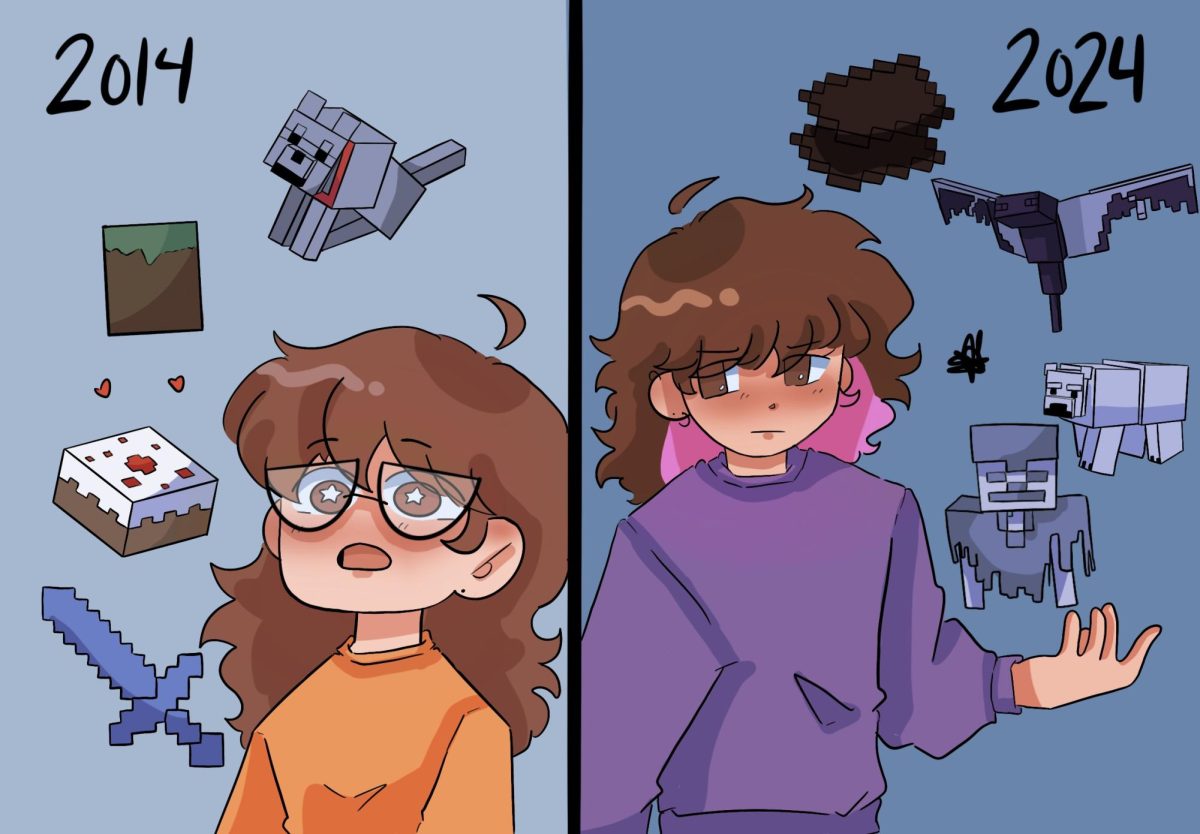“Minecraft” has taken the world by storm ever since its release in 2009. The blocky sandbox survival environment is made for a million and one possibilities so that any player of any age can play it how they want. With the rising popularity of YouTube and the gaming community as a whole, “Minecraft” became a worldwide phenomenon.
“Minecraft” did not stop evolving with its initial release. Throughout the years, parent company Mojang has added more and more to the game. At first, the updates truly made the game what it is known for today.
The introduction of a new realm was one of the first to spark excitement, otherwise known as the Nether, released in 2010. Players could now make a portal to a fiery dangerous place with all new creatures, items and places to explore. This was completely different from what early “Minecraft” YouTubers were used to. The drastic change from the “overworld” to the Nether became a staple in everything from “Minecraft” songs and parodies to completionist speedruns.
The most popular example would be the addition of creative mode, which was added on and off for a bit before being fully implemented in 2011 in the Beta 1.8 version. Many players who were uninterested in the game’s survival aspects could still play around with building in the “creative” mode, which allowed the player to fly, have access to all items and be invincible.
Along with the Nether, another realm was added, along with a technical “ending” to the game in 2011. With version 1.0 came the creatively titled region of The End. The End also added all new features, with the most notable being the first boss of the game, the Ender Dragon. Players were introduced to a credit scene, which had beautiful and now iconic messaging in its final lines, such as, “And the universe said I love you.”
Even when a lot of blocks were retextured in 2019 or Java Edition 1.14, the game still held a charm that was undeniable across the internet and player base.
From “Minecraft” YouTubers to casual players, everyone could agree “Minecraft” was one of the best games to come out in recent history. Or, at least, it was.
The game has undergone many updates. While players were extremely excited by the first few, it became rather exhausting with time. Many have begun to argue the game barely feels like its original IP at this point.
The 1.16 “Nether Update,” released in 2019, brought lots of cool additions to the Nether biome, but it also introduced “netherite,” which was the new strongest material in the game. This upset many players, as diamonds had been the strongest since the very beginning. Many players felt that introducing the new ore made diamond ore irrelevant to an extent, and with that, finding a diamond became less of an exciting experience, especially with how annoying it was to farm and get “netherite.”
One of the game’s most disappointing updates is often recalled to be the “Frostburn” update, or Java Edition 1.10, in 2016. While the update added new blocks like magma, nether wart and red nether brick, as well as new mobs such as strays (a snowy version of skeletons), polar bears and husks (a desert version of zombies), people found these additions to be underwhelming. Polar bears still hold zero use in the game other than being a set piece, even eight years later.
Trivial mobs like polar bears and mountain goats really highlight the main problem a lot of people have with the game at this point. Seasoned players feel like Mojang just keeps adding new things in order to fight for the game’s relevancy without fully fleshing out ideas and concepts.
A great example would be the “Wild Update,” or 1.19, added in 2022. While being hyped up as one of the coolest new updates, the additions were a letdown for many people.
The Warden and the introduction of Ancient Cities were supposed to make for a harder boss, as many had found the Ender Dragon too easy at this point; however, the Warden itself ended up being almost impossible to beat, being able to kill players in two hits — with the strongest gear in the game on. Not only is the Warden incredibly strong, it can attack through walls and in all directions, with both melee and aerial attacks. Multiple Wardens are able to spawn at the same time, leaving Ancient Cities pretty much unplayable. This left many players frustrated, especially because the Warden did not even drop anything incredibly useful if you were to succeed in killing it.
Along with this was the introduction of Allays, passive creatures made in order to be a companion to players and fetch items. Even though many were excited, a lot of players have never even encountered these, as they are extremely difficult to actually find. Though Mojang succeeded in making an interesting new concept, the execution was poor enough that many players didn’t even know it existed.
Lastly, frogs, tadpoles and swamp biomes were added. Again, many players were excited for this, but the new mobs and biomes did basically nothing. Mojang failed to even add new explorable structures to the swamp. Frogs and tadpoles fell into the same useless corner with polar bears. (So sorry, polar bears, I still love you.)
In my opinion, “Minecraft” needs to slow down. The game’s relevance, while in question before, has always stayed as one of the most popular games, and fans would easily wait just a bit longer to receive better and more flushed-out updates. The limitless possibility brought by its fun environment drew so many people to the game.
While I see the want to add more and more to the game to make it “better,” I think the real appeal of the game is not from the incessant updates and new features, but more from the simplicity the game had to offer at its core. At the end of the day, this is what has caused “Minecraft” to feel less and less like the game we grew up with.




